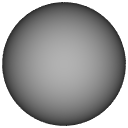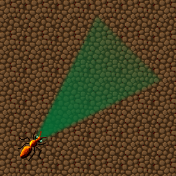Giving Sight and Sound to your actors.
Create an actor. You might name it 'ant' and use this animation.

Next, create another actor, and use an image somewhat like this:

Move it off the view area, and set it to not be created at start. You might put its parent as the view, so that you dont walk over it, depending on the nature of your game. It will be used to create a field that will detect noise.
In your 'ant' actor, select create actor event, and then action script editor. You could just use the action, but we want to do some stuff with it first.
In the script editor, select function create actor, and fill out the actor field that appears with AudioRange128 or whatever you called the animation. Make the offset 0 and 0 for this one. Make 'ant' the parent. hit add.
In the next line of the script editor, select ChangeTransparency and in its actor field, select the AudioRange128 actor. Please use a better name than I did! Select the highest level of transparency. Hit add.
Now go back and change that line that appeared. make the 1.00000 into 0.995. This makes the actor too faint to see, but not totally gone. if you can still see it, make it closer to 1.0, but dont go too far, or the actor will not affect other actors.
Close the script editor. Close the create actor event.
Now design your player collide events to collide with that circle. As longs as it has enough non-transparency, it will collide with other actors, but the player cannot see it. In its collision event, have it make the ant do whatever actions you want, based on the fact that the ant "heard" the player.
use something like this image for sight.

Follow the same steps as the soundrange actor, but put the offsets as 64 and -64. That should align the triangle with the ants head. The collision events of this actor can cause the ant to act out whatever is needed, based on the assumption that anything touching or in this field is in sight of the ant. you might need to put off assigning the transparency until you get it aligned right.
Feel free to use these graphics, but simple ones might be better, as you dont need the alpha gradient in them(a simple two color png would be smaller).
Please respond with any comments or questions. If there is any confusion in what I have said, I'd like to hear about it, so I can clear it up.
Here is a example of the sight field in use, with the field being Visible.


Next, create another actor, and use an image somewhat like this:

Move it off the view area, and set it to not be created at start. You might put its parent as the view, so that you dont walk over it, depending on the nature of your game. It will be used to create a field that will detect noise.
In your 'ant' actor, select create actor event, and then action script editor. You could just use the action, but we want to do some stuff with it first.
In the script editor, select function create actor, and fill out the actor field that appears with AudioRange128 or whatever you called the animation. Make the offset 0 and 0 for this one. Make 'ant' the parent. hit add.
In the next line of the script editor, select ChangeTransparency and in its actor field, select the AudioRange128 actor. Please use a better name than I did! Select the highest level of transparency. Hit add.
Now go back and change that line that appeared. make the 1.00000 into 0.995. This makes the actor too faint to see, but not totally gone. if you can still see it, make it closer to 1.0, but dont go too far, or the actor will not affect other actors.
Close the script editor. Close the create actor event.
Now design your player collide events to collide with that circle. As longs as it has enough non-transparency, it will collide with other actors, but the player cannot see it. In its collision event, have it make the ant do whatever actions you want, based on the fact that the ant "heard" the player.
use something like this image for sight.

Follow the same steps as the soundrange actor, but put the offsets as 64 and -64. That should align the triangle with the ants head. The collision events of this actor can cause the ant to act out whatever is needed, based on the assumption that anything touching or in this field is in sight of the ant. you might need to put off assigning the transparency until you get it aligned right.
Feel free to use these graphics, but simple ones might be better, as you dont need the alpha gradient in them(a simple two color png would be smaller).
Please respond with any comments or questions. If there is any confusion in what I have said, I'd like to hear about it, so I can clear it up.
Here is a example of the sight field in use, with the field being Visible.
